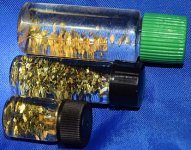wyalusing jim
Jr. Member
- Jan 6, 2011
- 23
- 19
first off, I'm a total newbie to gold prospecting. if I sound dumb, it's because I am.
I have a source for a nice quantity of paydirt which seems to have a fair amount of fine to super fine gold in it (nothing in a 30 screen, lots in the 50, 70 and 100 screens). I have tried the blue bowl with some success. I bought a miller table which so far has yielded nothing but a few flakes, it all washes off the table with the sand. now I am panning the classified material with better success.
I think that the problem with recovering this gold is that the flakes are not only small, but very thin and flat. any water current lifts some of the flakes and they flutter like leaves in the wind.
my question to you guys is, what is a good method to get this gold out of the sand at a decent rate of recovery?
I think a logical question you might ask is, am I sure that it's gold? I have had my dirt analyzed using x-ray spectroscopy and the analysis showed that my sample contained 5.56 ounces to the ton which I think is worth going after.
I'm working at this, but thought that maybe someone would be willing to advise or even help figure out the best method of recovery or at least concentration. I would be willing to give someone some of my material to try, if they would share their results with me.
I am located in northeast pa., so if anyone close by wants to try it we could meet, or I could mail some dried dirt to someone with experience with fine flakey gold.
thanks, jim
I have a source for a nice quantity of paydirt which seems to have a fair amount of fine to super fine gold in it (nothing in a 30 screen, lots in the 50, 70 and 100 screens). I have tried the blue bowl with some success. I bought a miller table which so far has yielded nothing but a few flakes, it all washes off the table with the sand. now I am panning the classified material with better success.
I think that the problem with recovering this gold is that the flakes are not only small, but very thin and flat. any water current lifts some of the flakes and they flutter like leaves in the wind.
my question to you guys is, what is a good method to get this gold out of the sand at a decent rate of recovery?
I think a logical question you might ask is, am I sure that it's gold? I have had my dirt analyzed using x-ray spectroscopy and the analysis showed that my sample contained 5.56 ounces to the ton which I think is worth going after.
I'm working at this, but thought that maybe someone would be willing to advise or even help figure out the best method of recovery or at least concentration. I would be willing to give someone some of my material to try, if they would share their results with me.
I am located in northeast pa., so if anyone close by wants to try it we could meet, or I could mail some dried dirt to someone with experience with fine flakey gold.
thanks, jim
Amazon Forum Fav 👍
Upvote
0










